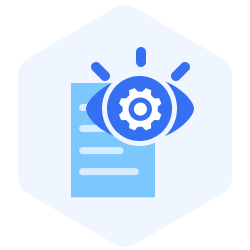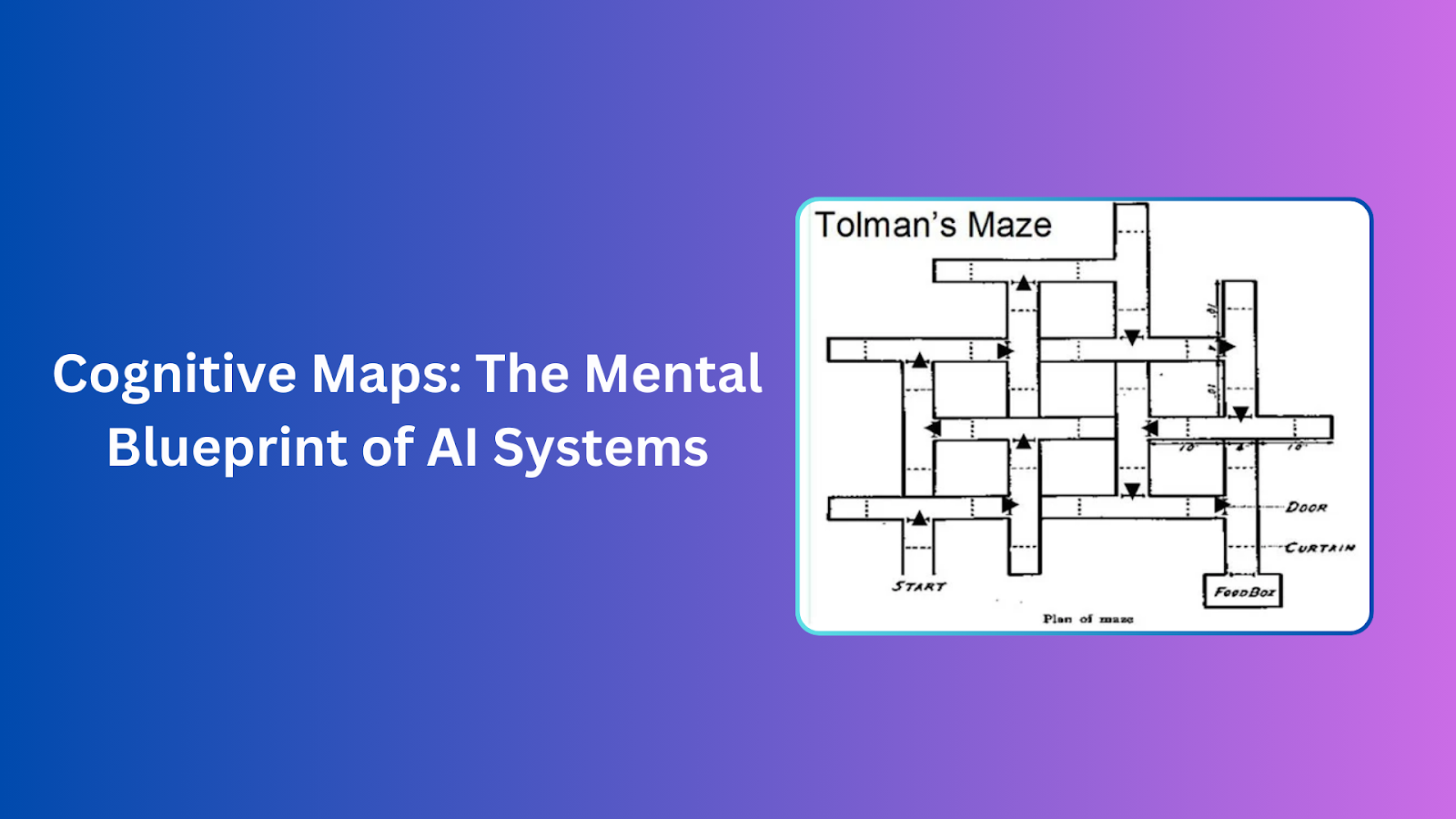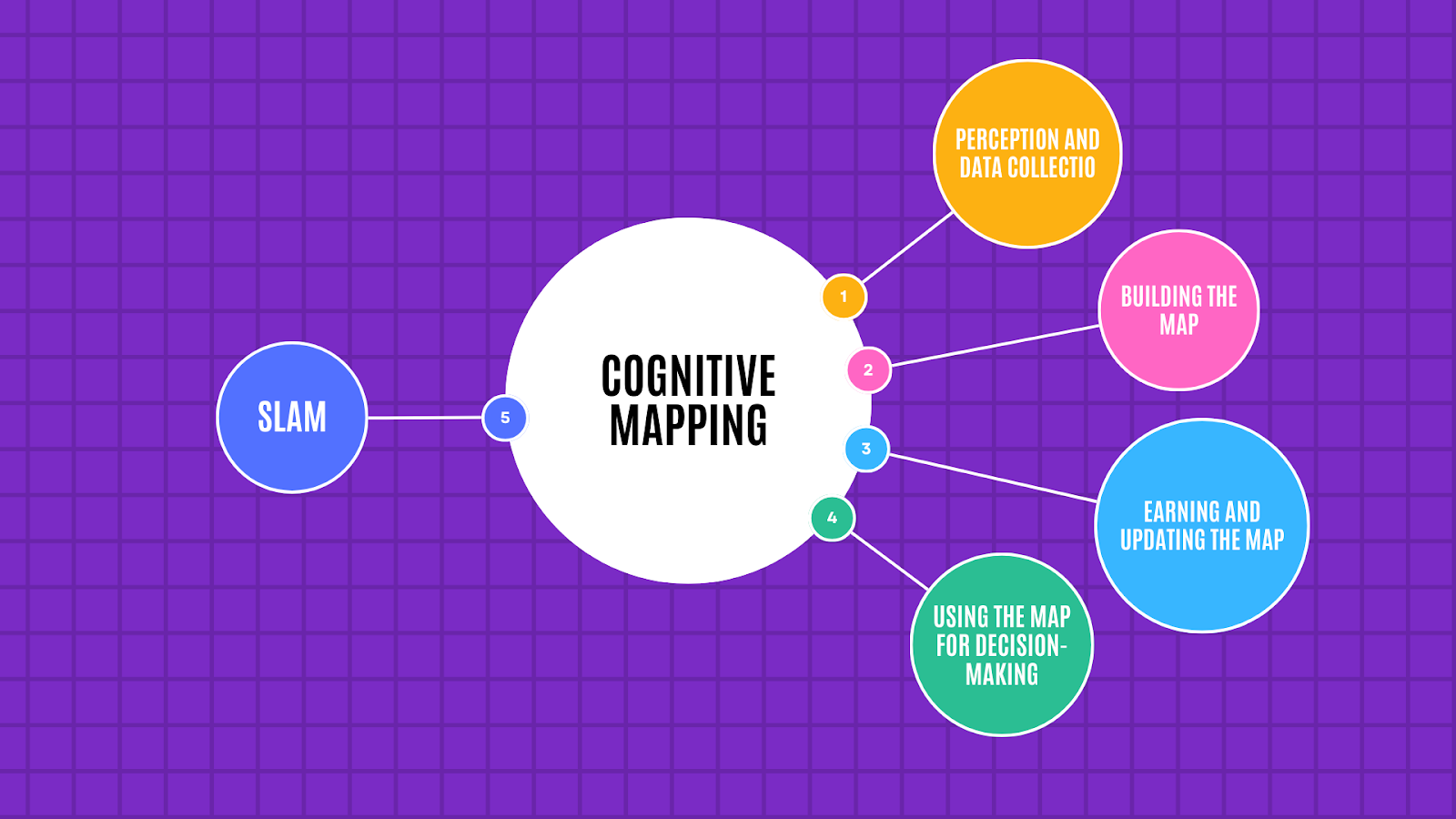Cognitive Maps: The Mental Blueprint of AI Systems

Cognitive Maps: The Mental Blueprint of AI Systems
 Cognitive Maps.png
Cognitive Maps.png
Cognitive Maps
Have you ever wondered how humans and animals navigate complex environments? Or how artificial intelligence (AI) systems can replicate this spatial awareness? Cognitive maps hold the key. This term was introduced by psychologist Edward Tolman in 1948 when he experimented with rats. Tolman observed that the rats could efficiently navigate a maze by forming mental maps, even without immediate rewards. From this experiment, he developed the idea of cognitive mapping—a mental representation of one's physical surroundings.
Today, cognitive maps extend beyond psychology into AI, helping systems learn, predict, and optimize their interactions with the world. This concept is important in advancing machine learning and improving spatial reasoning in AI.
Now, let's understand cognitive maps in detail, how they work, and their importance, benefits, and challenges.
What is a Cognitive Map?
A cognitive map is a mental representation of our physical environment that helps individuals understand and navigate their surroundings. It includes the spatial relationships between objects, locations, and paths, helping a person to recall directions, plan routes, and recognize important locations without relying on external tools like Google Maps. Cognitive maps are dynamic and adapt as new information about the environment is acquired.
In AI, a cognitive map is a structured model representing an environment or knowledge. It enables systems, particularly in robotics and autonomous technologies, to simulate real-world settings, predict outcomes, and make decisions based on understanding spatial relationships, much like humans do with their mental maps.
How Do Cognitive Maps Work?
Cognitive maps are built through a blend of sensory input, learning, and memory. Like humans, AI systems need to perceive their surroundings, learn from experiences, and update their understanding of the world. To understand how cognitive maps work in AI, let's break it down into several key aspects:
Perception and Data Collection
Building the Map
Learning and Updating the Map
Using the Map for Decision-Making
Self-Localization and Simultaneous Localization and Mapping (SLAM)
 Figure- Core Aspects of Cognitive Mapping.png
Figure- Core Aspects of Cognitive Mapping.png
Figure: Core Aspects of Cognitive Mapping
1. Perception and Data Collection
Cognitive maps in AI start with perception—gathering data from the environment. AI systems rely on different sensors, such as cameras, LiDAR, or GPS, to collect information. For example, in autonomous vehicles, the sensors continuously gather information about nearby objects, road markings, and pedestrians.
2. Building the Map
Once data is collected, the AI system processes it to build a representation of the environment. Cognitive maps are represented in AI as graph-based models or grid-based maps.
Graph-Based Models: Nodes represent objects or landmarks, and edges show their relationships. This model is particularly useful in decision-making processes such as determining the shortest path or predicting the next action.
Grid-Based Maps: The environment is divided into a grid, with each cell representing free or obstructed space. This approach is commonly used in robot navigation to identify available paths and obstacles. For example, a robotic vacuum cleaner uses a grid to map out furniture and walls as it cleans.
3. Learning and Updating the Map
AI agents continually interact with their environment, gathering new information to update the cognitive map. In dynamic environments where new obstacles may appear (e.g., construction zones), the system must adapt its map in real time.
For instance, a warehouse robot delivering goods may encounter a newly stacked pile of boxes blocking its usual route. In response, the robot updates its internal map and recalculates a new route to bypass the obstacle.
4. Using the Map for Decision-Making
Cognitive maps are the foundation for pathfinding and decision-making. Based on the map, the AI system simulates different paths or actions to find the most optimal route. For example, a robot uses the cognitive map to plan an optimal path from its current position to a target destination. In reinforcement learning, the agent uses the map to make decisions that maximize rewards over time.
5. Simultaneous Localization and Mapping (SLAM)
A core concept in cognitive mapping is SLAM, where the AI system simultaneously maps its surroundings while determining its location within that space. SLAM is important when an AI agent doesn't have prior knowledge of its environment. For example, when a robot enters a new room, it uses SLAM to map out the space while simultaneously tracking its own position.
Comparison: Cognitive Map vs. Symbolic AI vs. Concept Map
While seemingly related, cognitive maps, symbolic AI, and concept maps differ significantly in how they represent knowledge and enable AI systems to reason and learn.
| Aspect | Cognitive Map | Symbolic AI | Concept Map |
| Focus | Spatial representation and navigation | Focuses on explicit knowledge using symbols and rules. | Representing knowledge as a network of interconnected concepts |
| Representation | Graph-based or grid-based maps | Symbols, logic, and rules (e.g., "IF-THEN" statements) | Nodes represent concepts, links represent relationships |
| Strengths | - Enables efficient pathfinding and planning- Facilitates spatial reasoning and contextual awareness - Adaptable to dynamic environments | - Explainable and transparent reasoning- Can handle abstract and complex concepts | - Helps visualize and organize complex information - Facilitates knowledge discovery and understanding |
| Limitations | - Can be computationally complex for large-scale environments- May require substantial data to build accurate maps | - Brittle and inflexible in uncertain situations - Struggles with perception and learning from raw data | - Can be subjective and lack formal semantics - May not be suitable for spatial or temporal information |
| AI Applications | Robotics, autonomous vehicles, game AI, spatial understanding in NLP | Rule-based systems, theorem proving, knowledge-based question answering | Semantic analysis, educational technologies, concept learning |
Benefits and Challenges of Cognitive Maps
Now that we have covered the inner workings of cognitive maps in AI, it's important to understand their advantages and the challenges in their development and implementation.
Benefits
Real-Time Adaptation: Cognitive maps allow AI systems to adapt to new and changing environments. For instance, an autonomous drone can update its map to avoid an unexpected obstacle mid-flight.
Scalability: These maps can scale to represent large, complex environments. Self-driving cars, for instance, rely on large-scale maps of entire cities.
Enhanced Spatial Understanding: Cognitive maps enable AI to understand spatial relationships and contextual information, improving performance in tasks like navigation, image recognition, and language understanding.
Efficient Planning: Using cognitive maps, AI can plan actions more effectively and predict outcomes, which is essential for decision-making processes in complex environments.
Challenges
High Computational Requirements: Creating and updating detailed cognitive maps demands significant computational resources, especially in real-time.
Uncertainty in Dynamic Environments: Rapidly changing environments introduce uncertainty. For example, in urban driving, a self-driving car must constantly update its map to account for pedestrians or vehicles entering its path.
Sensor Reliability: Cognitive maps depend on reliable sensor data. Sensor malfunctions can lead to inaccurate maps, resulting in poor decision-making.
Applications of Cognitive Maps in AI
Autonomous Vehicles: Cognitive maps enable self-driving cars to navigate roads, understand traffic patterns, and plan optimal routes.
Robotics: Robots with cognitive maps can navigate indoor environments, perform tasks like delivery or cleaning, and interact with humans more effectively.
Natural Language Processing: Cognitive maps can improve AI systems' understanding of spatial language and context, enabling them to answer questions about locations and directions.
Recommender Systems: Cognitive maps can enhance recommender systems by incorporating user preferences and location data to provide more relevant and personalized suggestions.
FAQs
- What is the difference between a cognitive map and a mental map?
A cognitive map is a mental representation of spatial information used for navigation, while a mind map organizes ideas and concepts hierarchically. The two terms may seem similar but serve entirely different purposes.
- What is the role of SLAM in cognitive mapping?
SLAM (Simultaneous Localization and Mapping) enables AI systems to map an environment while tracking its location. It's critical in dynamic environments where prior maps are unavailable.
- What are the main industries benefiting from cognitive maps?
Industries such as autonomous transportation, robotics, and gaming significantly benefit from cognitive maps because they need real-time spatial awareness.
- What is the future of cognitive maps in AI?
Cognitive maps are expected to play an increasingly important role in AI, enabling machines to better understand and interact with the world around them. Future research may focus on developing more advanced and scalable cognitive mapping techniques and integrating them with AI capabilities like natural language processing and computer vision.
- What are the computational requirements for cognitive mapping in AI?
Cognitive mapping, especially in real-time systems like self-driving cars, requires significant processing power, robust sensors, and efficient algorithms to manage continuous updates and decision-making.
Further Reading
- What is a Cognitive Map?
- How Do Cognitive Maps Work?
- Comparison: Cognitive Map vs. Symbolic AI vs. Concept Map
- Benefits and Challenges of Cognitive Maps
- Applications of Cognitive Maps in AI
- FAQs
- Further Reading
Content
Start Free, Scale Easily
Try the fully-managed vector database built for your GenAI applications.
Try Zilliz Cloud for Free